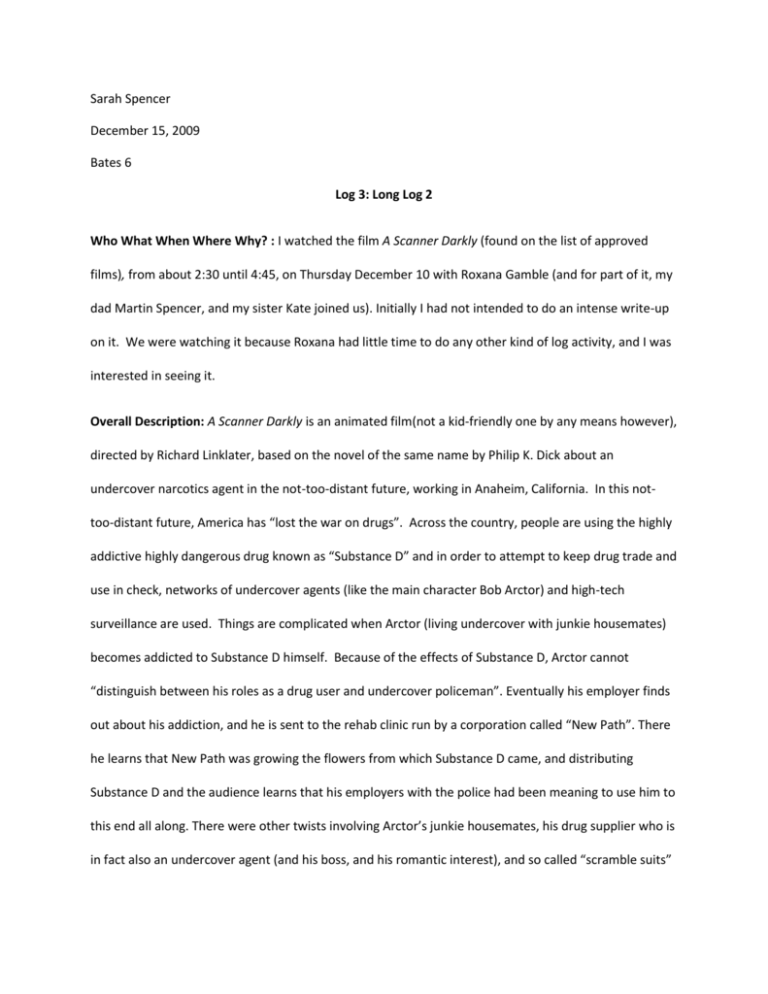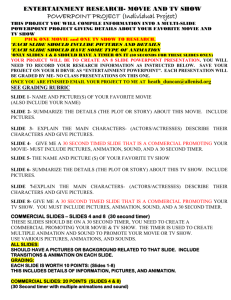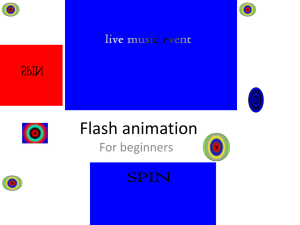Sarah Spencer December 15, 2009 Bates 6 Log 3: Long Log 2 Who
advertisement

Sarah Spencer December 15, 2009 Bates 6 Log 3: Long Log 2 Who What When Where Why? : I watched the film A Scanner Darkly (found on the list of approved films), from about 2:30 until 4:45, on Thursday December 10 with Roxana Gamble (and for part of it, my dad Martin Spencer, and my sister Kate joined us). Initially I had not intended to do an intense write-up on it. We were watching it because Roxana had little time to do any other kind of log activity, and I was interested in seeing it. Overall Description: A Scanner Darkly is an animated film(not a kid-friendly one by any means however), directed by Richard Linklater, based on the novel of the same name by Philip K. Dick about an undercover narcotics agent in the not-too-distant future, working in Anaheim, California. In this nottoo-distant future, America has “lost the war on drugs”. Across the country, people are using the highly addictive highly dangerous drug known as “Substance D” and in order to attempt to keep drug trade and use in check, networks of undercover agents (like the main character Bob Arctor) and high-tech surveillance are used. Things are complicated when Arctor (living undercover with junkie housemates) becomes addicted to Substance D himself. Because of the effects of Substance D, Arctor cannot “distinguish between his roles as a drug user and undercover policeman”. Eventually his employer finds out about his addiction, and he is sent to the rehab clinic run by a corporation called “New Path”. There he learns that New Path was growing the flowers from which Substance D came, and distributing Substance D and the audience learns that his employers with the police had been meaning to use him to this end all along. There were other twists involving Arctor’s junkie housemates, his drug supplier who is in fact also an undercover agent (and his boss, and his romantic interest), and so called “scramble suits” which the undercover agents wear when interacting with people at the police station to keep their identities secret. One Aspect In Depth: A Scanner Darkly was animated in a style that I initially wasn’t very fond of. Essentially the crew shot the movie “on film” (it was digitally recorded), and then animated it by tracing over the frames digitally. I decided that I wasn’t a fan of this technique before I even saw the movie because the style in which the frames were traced over was still realistic in its proportions and in the way people moved/interacted. I was of the mindset that that kind of animation style had no use because what’s the point of animating something if one traced over something already shot, and barely changed anything? I was of the mindset that animation should be stylized; otherwise why animate it at all? Having now seen the movie, I feel like it would have lost something had it been shot/animated any other way. This type of animation maintained some sort of realism- which helped me as a viewer to stay connected to the narrative- yet the subtle stylization allowed for effects that would detract from the narrative, had they been added-via computer generated images- into an otherwise live-action movie. Hallways can become slightly convex, shadows and light shift more noticeably than they do in reality, more emphasis (through use of color, more realistic texture, and more detail) is put on certain objects at certain moments. These subtler changes (only subtler in this animation style than they would be, were they pulled off in a regular live-action movie) add to the feeling that the viewer sees as the characters see in their drug-induced states, without overdoing it or creating nausea in the viewer. It’s a kind of surreal style of production that works extremely well with the substance of the film. As a soon-to-be art student that will possibly need experience in animation and some sort of media-production, these are the kinds of things that I think about when I watch movies, and the sorts of things that I feel I should think about. Personal Reactions: I was pleasantly surprised by this movie. I did not have high expectations for it. I found it far more interesting than I thought I would. I found it more humorous (in a dark and morbid way) than I had thought it would be, and it was more meaningful than I had imagined it would be. It was trippy…weird…a bit confusing after just one viewing, but all in an interesting (if not good) way. It took talking, and thinking about it after watching it for me to understand a bit better why it was on the recommended movies list (more detail will be in connect/compare/contrast). Thinking, talking and now writing on it also made me realize that I had underestimated the film- I initially wanted to use it only as a short log, but I realized after writing a bit, that I had more to say about it than I thought I did. I probably wouldn’t have watched it had it not been on the list of movies for logs, had Roxana not needed to watch a movie, and I’m glad I did watch it. So basically what I’m saying is- I liked A Scanner Darkly, and I think it was a good log experience. Connect/Compare/Contrast: I really love my senior year classes because they connect so well. After watching A Scanner Darkly, once it’s revealed, at the end, that the police were using Arctor (the main character) to find something out, I realized that that ending raised ethical questions like those that we have been trying to answer in my Honors Philosophy class. There is an ethical theory called Deontology. Deontologists believe that the moral worth of something comes from the moral value of each action. They believe that no matter what the results, it matters whether singular actions are right or wrong. A huge part of deontological theory is the idea that no matter what the results are, people should not use other people as means to an end- because deontologists believe that the end is irrelevant. From a deontological standpoint, the police who sent Arctor to New Path to find out about what they hypothesized were morally wrong in their actions. What it took to get Arctor to New Path destroyed him. He became intensely addicted to Substance D, he lost his sense of self, he lost his name, his way of life. He was essentially reduced to a nearly mindless empty shell of a person by his use of Substance D. This destruction of himself was the only way he could seem enough of a non-threat for the people at New Path to move him to a different clinic- the farms where the flower sources of Substance D were grown- where he would find what the police wanted him to find so that they would have proof. Such destruction of a life- even for the purposes of others- would not sit well with deontologists. Another ethical theory is utilitarianism. The utilitarian theory of one British philosopher, Jeremy Bentham, would support the actions of the police, while deontological theories would condemn them. Bentham’s theory says that the actions that bring the greatest amount of happiness to the greatest amount of people, and as a subset of consequentialism, utilitarians believe that the ends do justify the means. A utilitarian would say that if the police were using Arctor in order to better life for many other people (by eliminating the source of the drug that so many people were destroying their lives with), the happiness and betterment of the large numbers of other people would outweigh the suffering Arctor had to go through to achieve it. On a technical level, A Scanner Darkly can be compared to Nigel Spivey’s points about sculpture. To return to a discussion on the animation style… Heavily stylized animation- more like Disney, or cartoon animation- can be compared to overly exaggerated sculpture and depiction of the human form, like the Venus of Willendorf. Of course, no animation at all- live action movies- could be compared to highly perfectly realistic sculpture like Kritios boy. Which leaves the almost-realistic-but-not animation style of A Scanner Darkly to be compared with sculptures which seem realistic but technically aren’t- like the Riace bronzes. Disney movies exaggerate in their animations. Disney caricatures actions, exaggerate movements and human features. This is fitting for the kinds of plots that Disney animates. Live action movies can exaggerate through use of special effects, but the goal of live action films is to make something believable, even if a situation is impossible, the filmmakers need to make it look realistic. With A Scanner Darkly, the necessity for realism is suspended because it’s animated, yet the animation style is realistic, so the viewer is kind of accepting the weird subtleties that may occur in the movie, because it’s animated, while still remaining connected to the plot and “believing” what is happening, because of the animation style.








